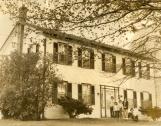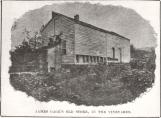1
The Gage Family Homestead3
Welcome to Battlefield House Museum and Park. Won't you join us as we step over the threshold of the Gage homestead and visit a while with the Gages? As we turn the pages of time you'll meet Mary Jones Gage, the mother of James and Elizabeth, view the portraits of James and his wife Mary Davis and explore the site from the War of 1812 to the present day.6
Battlefield House was the home of the widow Mary Jones Gage and her two children, James and Elizabeth, who journeyed to the area from New York State around 1789.Their first home was probably a rough-hewn log house - there is some evidence that the present Battlefield House may be standing on the foundations of this original dwelling.
A storey and a half frame house with two fireplaces was built in 1796 and it was not until around 1830 that the house was built up to a full two storeys.
On the Assessment Rolls of 1816, 1818 and 1819, the Gages' property is assessed as one of the most valuable in Saltfleet Township. The family was still living in their storey and a half frame house, but, compared to the rest of the houses in the township which were mostly one-storey squared-timber, it must have been rather grand. By 1819, the Gages had 70 acres of cultivated land and 1380 acres of uncultivated land; they also had two oxen, two horses, two horn cattle and eight milch (sic) cows.
7
Mary Jones Gage's husband, James Gage (Sr.), was killed in 1777 defending Forts Clinton and Montgomery during the American Revolutionary War. As a result of his death, Mary was entitled to seven years of James' half pay.Mary and her two teenaged children, James and Elizabeth, emigrated to Upper Canada in 1789.
Some of Mary's family had already settled in Upper Canada. Augustus Jones, Mary's brother, had made a name for himself in Upper Canada as a prominent surveyor. Many of Mary's brothers and sisters followed Augustus' lead into Upper Canada.
James Gage Sr.'s brother William had also emigrated to Upper Canada and had a six hundred acre farm in Saltfleet Township. Descendants of William Gage settled in a house in what is now Gage Park in Hamilton.
Mary Jones Gage lived a long life, passing away in 1841 at the age of 96. She was burried at the First Methodist Church located at King and Wellington Streets in Hamilton. Redevelopment of the Church property in the early 1970s resulted in many of the caskets, including Mary's, being relocated to Woodlands cemetery in Burlington. Many of the grave stones were used as sidewalk paving stones. Today, a plaque in recognition of the early pioneers is Mary's marker in Woodlands cemetery.
9
In 1796, both James and Elizabeth were married. James married Mary Davis, whose Loyalist family had come to Upper Canada from North Carolina and later settled on Mud Street in a house they called "Harmony Hall", pictured here. Harmony Hall was demolished in the late 1970s.James and Mary made their home with James' mother and eventually had ten children, six girls and four boys.
11
The portrait of James Gage hangs in the main hallway of Battlefield House Museum, alongside that of his wife, Mary. These were likely painted by an itinerant portrait painter in 1851. At a time before photography became widely used, portrait painters would travel from house to house. Those who chose to have their portraits painted were often the wealthier people in the community. Such portraits came to represent a higher social status.This painting is likely to have hung in the house the Gage family moved into after they left Stoney Creek. The Gages moved to Hamilton in approximately 1835, where James Gage was a director of the Gore Bank.
The portraits were donated to the Museum by the Freeman family, descendants of James and Mary Gage.
The portraits of James and Mary were restored in 2001. This restorative work ucovered the object in James' hand more clearly, which is believed to be a miniature portrait of a man.






